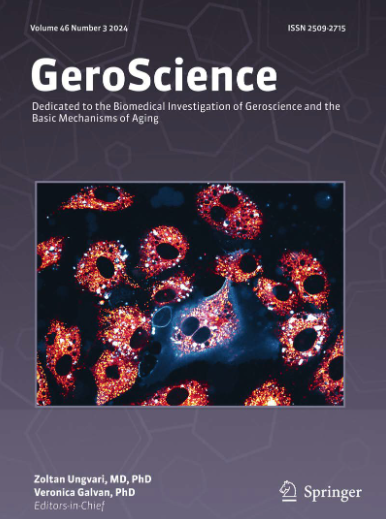Impaired early type I interferon responses to influenza virus infection in aged mice are associated with subsequent increased pulmonary inflammation.
IF 5.4
2区 医学
Q1 GERIATRICS & GERONTOLOGY
引用次数: 0
Abstract
Seasonal influenza is responsible for significant mortality and morbidity worldwide. Seventy to ninety percent of these deaths occur in those aged 65 or older. To determine the innate immune responses to influenza A virus (IAV) infection, young (12-week) and old (70-week) C57BL/6 J mice were infected intranasally (i.n.) with IAV PR8. Immune responses were determined by qRT-PCR and single-cell RNA sequencing (scRNA-seq). Old mice, as compared to young mice, had significantly higher viral loads and lower type I interferon (IFN) expression in the lung at 3 days post-infection (dpi). In contrast, at this time point aged mice had significantly higher amounts of type III IFN expression, which correlated with the higher viral loads observed. Histopathology revealed that IAV infection in old mice resulted in lower pathological scores early (at 5 dpi) and higher lung pathological scores of diseases later (at 7 dpi) than in young mice. scRNA-seq analysis revealed that, at 7 dpi, older mice exhibited sustained local inflammatory responses, with higher expression levels of Ddx58, Irf7, Il6, and Tnf across various immune cells, including macrophages, monocytes, Natural killer cells, dendritic cells, and granulocytes, compared to young mice. Our murine model of aging and influenza infection demonstrated that aging dysregulated early IFN responses to influenza infection resulting in enhanced viral replication. These altered IFN responses in old mice also result in enhanced lung inflammation late after infection and may increase the incidence of secondary bacterial infections seen in older individuals.老年小鼠对流感病毒感染的早期I型干扰素反应受损与随后肺部炎症的增加有关。
季节性流感在世界范围内造成严重的死亡率和发病率。70%到90%的死亡发生在65岁或以上的人身上。为测定小鼠对甲型流感病毒(IAV)感染的先天免疫应答,将幼年(12周龄)和老年(70周龄)C57BL/6 J小鼠经鼻内感染IAV PR8。采用qRT-PCR和单细胞RNA测序(scRNA-seq)检测免疫应答。与年轻小鼠相比,老年小鼠在感染后3天(dpi)肺部的病毒载量显著增加,I型干扰素(IFN)表达显著降低。相比之下,在这个时间点,老年小鼠的III型IFN表达量显著增加,这与观察到的较高病毒载量相关。组织病理学结果显示,IAV感染老年小鼠早期(5 dpi)病理评分较低,后期(7 dpi)肺部疾病病理评分较年轻小鼠高。scRNA-seq分析显示,在7 dpi时,老年小鼠表现出持续的局部炎症反应,与年轻小鼠相比,各种免疫细胞(包括巨噬细胞、单核细胞、自然杀伤细胞、树突状细胞和粒细胞)中Ddx58、Irf7、Il6和Tnf的表达水平更高。我们的小鼠衰老和流感感染模型表明,衰老失调了早期IFN对流感感染的反应,导致病毒复制增强。老年小鼠中IFN反应的改变也导致感染后晚期肺部炎症增强,并可能增加老年人继发细菌感染的发生率。
本文章由计算机程序翻译,如有差异,请以英文原文为准。
求助全文
约1分钟内获得全文
求助全文
来源期刊

GeroScience
Medicine-Complementary and Alternative Medicine
CiteScore
10.50
自引率
5.40%
发文量
182
期刊介绍:
GeroScience is a bi-monthly, international, peer-reviewed journal that publishes articles related to research in the biology of aging and research on biomedical applications that impact aging. The scope of articles to be considered include evolutionary biology, biophysics, genetics, genomics, proteomics, molecular biology, cell biology, biochemistry, endocrinology, immunology, physiology, pharmacology, neuroscience, and psychology.
 求助内容:
求助内容: 应助结果提醒方式:
应助结果提醒方式:


